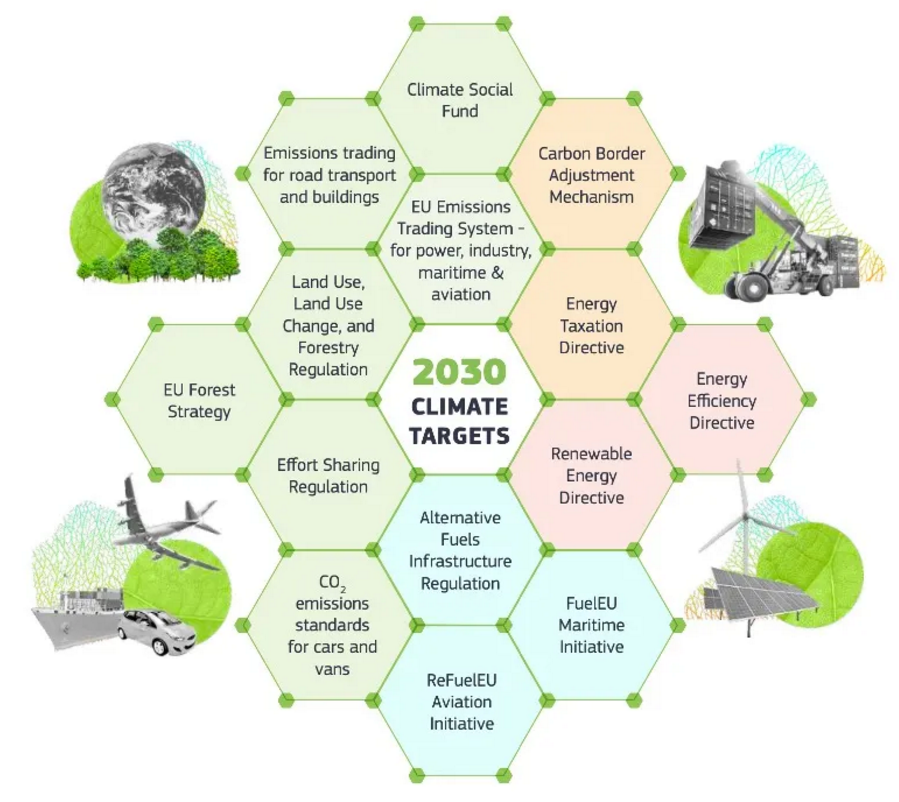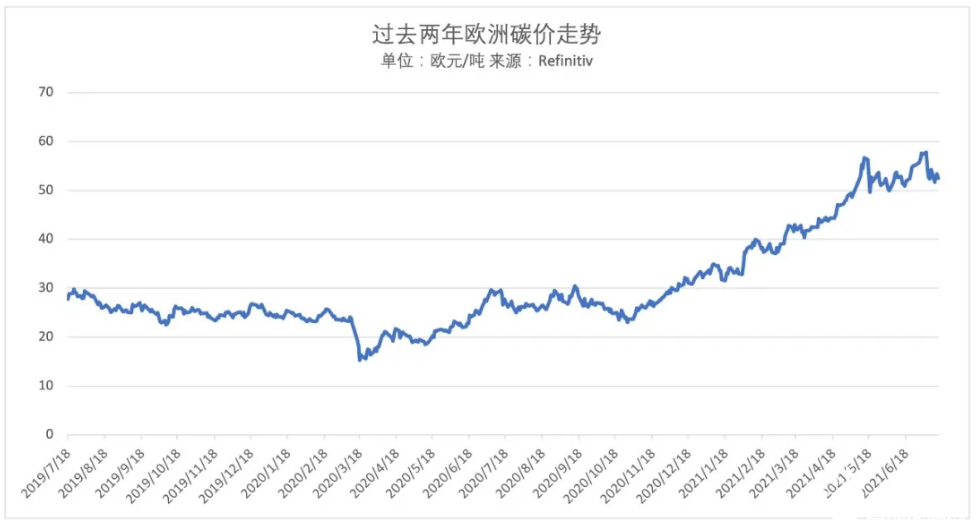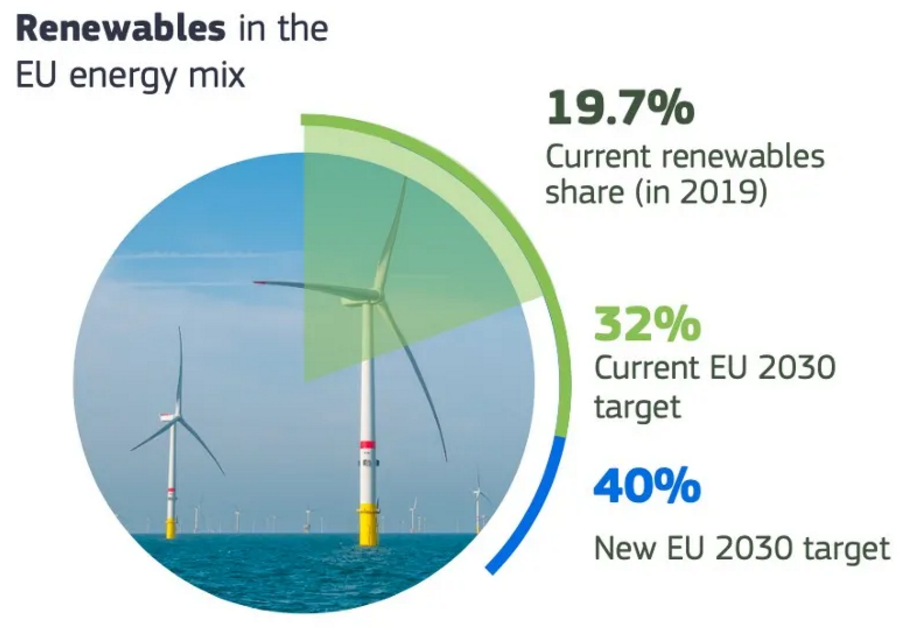The EU has unprecedented green new deal with the imposition of carbon tariffs and the prohibition of
Within the EU, the followup game and landing will still be a long process; The biggest impact on China is the introduction of carbon tariffs.

On July 14 local time, the European Commission officially launched the "European Green deal", which further defined the goal of reducing greenhouse gas emissions by 55% by 2030 compared with 1990, and planned to achieve carbon neutrality by 2050.
In the 2015 Paris Agreement, the EU promised to reduce emissions by 40% by 2030 compared with 1990. In September 2020, the EU will raise its emission reduction target to 55%. In June 2021, the EU climate law will be implemented, and achieving carbon neutrality by 2050 will become a statutory goal.
The "green new deal for Europe" has drawn up a detailed roadmap for the EU to achieve this goal, involving carbon market, energy, energy efficiency, transportation, construction, carbon border regulation mechanism and other fields. European Commission President Ursula von Draine said at a press conference on the 14th that Europe is now the first continent to set a comprehensive framework for achieving climate change goals.
Europe has been exploring green energy transformation, carbon market, electricity market, green transportation and other climate change related issues for many years, and the consensus on green transformation and related market mechanisms are leading the world. Under the big goal of reducing emissions by 55% by 2030 and achieving carbon neutrality by 2050, the EU's green transformation will be faster and wider, and the operating costs of related industries will be increased. The carbon tariff mechanism will face international pressure, and the problems of competition fairness and social fairness brought about by the transformation will also face challenges. Whether the scheme can be successfully implemented is still facing a test.
 Figure 1: framework of EU green administration program source: European Commission
Figure 1: framework of EU green administration program source: European Commission
01
Fuel vehicles banned in 2035
In the field of transportation, the green new deal proposes to reduce carbon emissions by 90% by 2050 compared with 2021. Land transportation contributes 20.4% of the EU's greenhouse gas emissions, which is the focus of emission reduction. The plan sets the target of reducing the emissions of passenger cars and vans by 55% and 50% respectively by 2030 (the previous target was 37.5% and 31% respectively), and proposes for the first time that the new vehicles sold in 2035 will be zero emission vehicles, which means that the EU will ban the sale of fuel vehicles from 2035.
Starting from 2026, carbon emissions from road transportation will be covered by carbon trading, pricing its pollution, thus indirectly stimulating investment in clean transportation technology.
In order to support the development of new energy vehicles, it also needs a lot of investment in infrastructure such as charging piles. The plan proposes to set up a charging station every 60 km and a hydrogenation station every 150 km on the main highways by 2030.
It is estimated that there will be 3.5 million charging stations in Europe by 2030 and 16.3 million by 2050. In terms of new fuels, the EU plans to generate 2% of transportation fuel from green hydrogen and 2.6% from biomass by 2030.
Aviation and shipping account for 3.8% and 4% of greenhouse gas emissions respectively, and the EU plans to gradually reduce its emission quota. In terms of aviation, the EU plans to reduce the annual emission quota by 4.2% for internal routes in Europe, and will no longer provide free quotas from 2026. All the carbon emissions required by enterprises will be purchased from the carbon market; In terms of shipping, it will take three years from 2023 to gradually bring shipping carbon emissions into the European carbon market, focusing on the carbon emissions of large ships.
02
Further expansion of the role of carbon market
Carbon market is the key role in EU green new deal. In the past 16 years, the carbon emission intensity of power, heating and high energy consuming industries covered by the carbon market has decreased by 42.8%, contributing significantly to emission reduction, mainly from the power generation industry. Due to the expectation of the green new deal, especially after the EU first proposed the target of reducing emissions by 55% by 2030 in September 2020, the carbon price of the EU carbon market has been constantly reaching a new high in the past six months, and is now stable at more than 50 euro / ton.

Figure 2: Trend of carbon price in Europe
According to the EU's plan, the carbon market quota will be tighter in the future. The EU plans to reduce carbon emissions in the areas covered by the carbon market by 61% by 2030, compared with that when the carbon market was established in 2005, which means that there is still an 18% gap. Therefore, the EU plans to increase the reduction rate of carbon market quota from 2.2% to 4.2% per year in the future, and designs a mechanism to adjust the total quota flexibly. At the same time, the European Commission proposes to retain the 24% reduction rate of excess quota under the market stability reserve mechanism.
The scope of the carbon market will also expand. The European Union plans to phase out the free carbon quota for aviation and to include shipping into the carbon market. For road traffic and construction, the EU plans to set up a new independent carbon trading system, which is planned to be implemented from 2025. The target of the system is fuel providers, not car owners and homeowners.
Qin Yan, chief power and carbon analyst at Luft, told Caijing that the core of the green new deal is to deeply reform the EU carbon market. The EU regards carbon market as the cornerstone of climate policy, and proposes to expand the coverage industries to shipping, highway transportation and construction industries, make full use of carbon price to guide green low-carbon investment and energy efficiency investment, and use the income from quota auction for innovation fund and social climate fund to ensure social equity under climate change policy.
With so many reforms, where will the rising European carbon price go? Qin Yan said that the EU's strong climate policies will continue to support the EU's carbon price, such as substantially raising emission reduction targets for industries covered by the carbon market and reducing quotas. In general, the EU carbon price will remain at the current price of around 50 euro in the past two or three years, which will promote the development of clean energy and further promote the decarbonization of the European power industry. The high carbon price will make the industrial sector more aware of the importance of emission reduction, and encourage the industry to invest in low-carbon technologies, such as CCUs, hydrogen energy, etc. Luft carbon research expects EU carbon prices to rise to nearly 100 euros by 2030.
Enterprises affected by the carbon market will also be more cautious. Qin Yan believes that the traditional industries covered by the carbon market, facing the reality that they need to buy quotas through auction, will be more cautious in selling the existing excess quotas. The market stability reserve mechanism will further reduce the excess quota, reduce the amount of auction quota every year, further tighten the supply and demand of carbon market quota, and increase the carbon price.
The shipping industry, which is newly included in the carbon market, should also gradually start to purchase EU carbon quotas. Therefore, although this measure is extended to the shipping industry, it will face opposition from the shipping industry of other countries. The final result is uncertain, and it does not rule out that some enterprises should make early layout and purchase EU carbon quotas as hedging.
03
Carbon border adjustment mechanism implemented in 2026
The biggest impact of the EU green new deal on China is the CBAM (carbon border adjustment mechanism), which is called "carbon tariff". If it is landed, the EU will become the first economy in the world to implement carbon tariffs.
The EU believes that under the background of improving its own climate objectives, non EU countries do not have the same intensity of environmental and climate policies, which will lead to the so-called "carbon leakage", that is, emissions transfer to the outside of the EU, which will affect European and global efforts to cope with climate change. Therefore, it is necessary to introduce new mechanism to the imported products of the EU and price the pollution produced in the process of production of imported products.
In other words, products exported to the EU need to pay for carbon emissions generated in the production process, which is reflected in the CBAM voucher, which will be linked to the average price of the European carbon market every week.
In the first stage, the carbon border adjustment mechanism will include five industries, namely cement, steel, aluminum, fertilizer and power. From 2023 to 2025, it is the trial operation stage. In this stage, export enterprises only need to submit emission data. It will be implemented in 2026. Since 2026, EU importers need to report the emission data of products imported into the EU in the previous year before May 31 every year, and submit CBAM certificate calculated according to emission data. In addition, if the importer is able to prove that the carbon price has been paid according to verifiable evidence submitted by the third country manufacturer, the corresponding amount can be deducted.
As it involves taxation of products exported to Europe, Chinese related enterprises will have potential impact. Qin Yan analysis believes that, from the perspective of trade intensity, the EU carbon border regulation mechanism will inevitably affect China's steel and aluminum exporters. Although it is still five years from the implementation of this mechanism, enterprises should prepare as early as possible.
First, establish a sound system for the detection and verification of energy consumption and carbon emission data of enterprises as soon as possible, and conform to international standards, and strive to have a better advantage in negotiation with the European Union carbon authorities; Second, early layout, reduce the carbon footprint of products; Third, actively participate in China's carbon market and strive to make the carbon price cost paid in China as the equivalent climate policy with the EU.
The introduction of the carbon border regulation mechanism is also full of games within the EU. Qin Yan said that the subsequent negotiations on the proposal will face greater variables. On the one hand, European steel and aluminum enterprises are reluctant to lose their current free quota. It is believed that the current carbon market mechanism has enough incentive for low-carbon development of industry, and does not need to introduce new complex carbon tariff mechanism. The carbon market reform will also push up carbon price and affect the cost of industrial enterprises, Aluminum is calling for its own removal from carbon tariffs, citing indirect emissions and retaliation from trading partners.
Qin Yan said the current plan introduced a three-year transition period, which was delayed to 2026, and the reduction of free quota for industrial enterprises was delayed until 2026. These measures have been much looser than the previous proposal for leak out, and the European Commission has made concessions under pressure from the industry; On the other hand, many think tanks and NGOs in the EU believe that free carbon quotas will only bring extra profits to the industry, and they advocate cutting carbon quotas as soon as possible. In the next legislative negotiations, both sides will be more tit for tat.
04
Renewable energy increased to 40 percent
Green energy transformation has always been the core issue of climate change. Greenhouse gas emissions in energy sector contribute 75% of European emissions. EU package starts from two aspects: improving clean energy share and improving energy efficiency.
In terms of energy structure, renewable energy accounts for 19.7% of the energy structure in Europe in 2019. The EU plans to increase the proportion to 40% by 2030, which is significantly higher than the previous 32% target. The EU has also set renewable energy share targets for different areas such as transportation, heating and refrigeration, construction, industry and so on.
 Figure 3: renewable energy to 40% by 2030
Figure 3: renewable energy to 40% by 2030
In order to promote new energy investment and development, the EU will also improve policy mechanism, accelerate the approval of new energy projects, promote the measures of renewable energy power purchase agreement (PPA), set up goals and certification mechanisms for renewable hydrogen production, promote cross-border cooperation to promote renewable energy project financing, etc.
The transformation of energy structure focuses on the production of energy, while the EU also pays equal attention to the role of energy efficiency improvement on emission reduction on consumption side. The program proposes a 36-39% goal of energy efficiency improvement by 2030, which is also improved compared with the previous 32.5 percent target. This means that all Member States meet European energy efficiency standards, increasing the annual rate of energy efficiency from 0.8% to 1.5% from the current one from 2024 to 2030, almost doubling.
In addition to these areas, the programme has also developed detailed plans in many related fields, such as environment, soil, agriculture, social climate fund, tax, emission reduction sharing resolution (ESR). The EU press release said that these programmes are all interconnected and complementary, and we need this balanced package and the value it generates to ensure that Europe completes its transformation fairly, green and competitive, and that it shares responsibilities among different sectors and Member States to provide additional support when appropriate.
05
Disputes and challenges
European parties are still divided on the plan, especially on the expansion of carbon market and the implementation of carbon border adjustment mechanism.
The European Parliament, European government officials and environmental organizations generally welcomed the programme, and some environmental organizations believed that the transformation was still not fast enough. Many business representatives worry that radical transformation programs will weaken the competitiveness of European companies. Siegfried russwurm, President of the German Industrial Association (BDI), said the EU had proposed a bold and concrete road map, but lacked on how to ensure the safe competition for European industry and innovation; Climate planning will succeed and find followers only if the industry remains globally competitive in the decarbonization process.
Wolfgang gro e entrup, director of the German Chemical Association (VCI), reminded that the company needs to protect a fair competitive environment, otherwise it is possible to become a climate neutral Europe without industry instead of creating a climate neutral European industry. With regard to the carbon border regulation mechanism, he also said in a clear manner that the signal from our international trading partners was clear: the EU's carbon tariff test was dangerous and doomed to failure.
Hildegard m ü ller, President of the German automobile industry association, disagreed with the prohibition of the sale of fuel vehicles in 2035. He thinks that this limits innovation and technology openness, limits the choice of consumers, has a huge impact on many suppliers, also affects employment, and lacks comprehensive consideration of economic and social impact. On the other hand, he welcomed the legal support for the expansion of charging facilities proposed by the programme, and believed that there was room for improvement in the construction objectives of the hydrogenation station and the objectives of renewable fuels.
Carbon tariff is another key issue. Besides the above-mentioned disputes within the EU, it is still controversial whether it has effect, how to implement it and whether it conflicts with existing international trade rules.
Although the EU claimed in the programme that the carbon border regulation mechanism is compatible with WTO rules, this has not been agreed internationally. George roderburg, a partner of international law firm fulder law firm based in London, believes that there is still a dispute over whether CBAM is in compliance with WTO law, especially the non discrimination rules under GATT. First, there are signs that EU steel, iron, aluminum and fertilizer producers will have a greater advantage than non EU producers. For example, EU carbon dioxide emitters can now purchase quotas, valid until 2030. Therefore, they can compensate for future emissions by handing over quotas obtained before CBAM is implemented. The result is that EU emitters can save costs, and non EU companies that produce CBAM products cannot. Secondly, the rules on compensation for carbon prices paid in third countries may violate WTO MFN principles.
It is also one of the concerns that how quickly the EU's ambition to transform can form consensus and achieve its goal. In a comment released before the proposal was issued, Siemens Energy CEO said that it is important to set the right goals, but more importantly, to accelerate the implementation of the project, especially the approval process. In Germany, for example, it takes 12 years to build a transmission line, and such a long cycle is fatal for any energy transformation.
In addition, the social equity impact of transformation on low-income people is also one of the focus of controversy. Pascal canfin, chairman of the European Parliament environmental committee, said in a statement after the new green deal issued that it proposed to include emissions from transportation and construction into the carbon market and set carbon prices. However, for living in a place about 20 or 30 kilometers away from the city, there is no other choice for public transport, and the carbon price will only increase costs in vain and will not bring about emission reduction.
Svenja Schulze, German Minister of environment, commented on the programme, and the second emphasized fairness and solidarity. She said that low-income groups and regions need help to achieve climate neutrality in particular, and that climate protection will succeed only in a social way.
Next, the relevant legislative plans of the scheme should be approved by the European Parliament first, and also approved by the European Council. Under the multi-party interest game, it can be met that the subsequent negotiation, game and landing will still be a long process.
The article is from the international energy network

2021
?
山西凱翔凱宇科技·致力研發(fā)清潔能源
綠色能源 & 創(chuàng )新科技
用綠色能源喚醒城市
-
業(yè)務(wù)咨詢(xún)  400-880-0226
400-880-0226
識別二維碼

商務(wù)合作請留言
END.